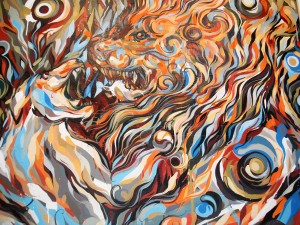Street artist celebrates color and attention to detail
Imagine you’re walking to your local liquor store when you unexpectedly encounter a giant M painted in swirling patterns on top of an equally mesmerizing blue background, occupying the wall from top to bottom.

In the jungle · Victor Reyes’ “Lion,” currently on display at Known Gallery as part of his art show The Jungle, demonstrates the artist’s affinity for jump-off-the-wall color use and extreme attention to detail. - Eva Recinos | Daily Trojan
This giant “M” is one of street artist Victor Reyes’ many works of art.
Reyes began painting in the ’90s and his work has been shown in a multitude of countries, from Japan to Germany. Notably, over the course of two years, Reyes managed to paint all 26 letters of the alphabet on the streets of the Mission District in San Francisco.
His art changed the landscape: Now residents could walk past the usual walls and alleys and see them transformed into an artist’s canvases.
His second solo show at Known Gallery on Fairfax Avenue, titled The Jungle, strives to explore the nature of humanity and survival and uses the human body and animals as common themes. Even the colors are chosen purposefully to evoke emotion or more deeply portray the human body.
With The Jungle, Reyes proves that his command of color and type has remained strong. Though the pieces of The Jungle can be frightening at times and calming at others, all are consistently intricate and eye-catching — Reyes’ pieces practically leap from the white walls of the gallery.
But even when the colors of his pieces are muted or black and white, the complexity of Reyes’ works make them compelling. “Diamond,” one of the first pieces visitors see as they walk in, is a good example of this, as it uses a strictly black-and-white palette to great success. Its swirling patterns are contrasted by some well-placed hard lines, and the conglomeration is set off in the shape of a diamond placed against a black canvas. The piece, which features mixed media on wood, can keep a viewer staring for more than just a couple of minutes.
Across the wall lies “The Jungle,” a piece contrasting the simple palette of “Diamond” with an explosion of color. Its many details, from dripping paint to circular shapes that look like eyes, show how Reyes can create as much intricacy with color as he can with only black and white. The beautifully chaotic piece keeps the viewer’s eyes in motion and shows off Reyes’ ability to choose the right way to blend dark colors with bright ones.
Much of Reyes’ work challenges the viewer to look more closely. If seen from far away, “Lions” looks only like a canvas with a variety of bright and neutral colors swirling together.
But upon closer examination, a viewer can spot two feral animals fighting each other. A lion’s large face, with perhaps a paw below, emerges from the many colors with bright orange strokes. The lion’s face is intricately painted, with small dabs of color sprinkled everywhere, including the tip of the lion’s nose. The opposing animal shows the same attention to detail, but with more subdued colors.
Reyes also demonstrates his talent with typography, creating some pieces dedicated to playing with the image and shape of letters. The letters won’t reel many viewers in quite as much as the other pieces do, but they still recall Reyes’ ability to craft visually engaging works of typography.
Not all works are displayed on traditionally shaped canvases: Certain pieces are set up together and even stacked, such as with a triangular canvas on top of a rectangular one.
Some relationships between canvases are clearer than others, but all the triangular pieces manage to communicate a savage or dark feeling within a small space, featuring a use of darker colors and images of subjects like skulls and tigers.
Reyes also shows off some unconventional ingenuity: Several pieces named “Quilt” run along a wall, placed right next to each other with their respective numbers; the pieces are displayed together, but sell separately. The idea of creating a quilt-like display, and naming the pieces so, cleverly presents the idea that even if the pieces in the show seem different, they are related.
The Jungle doesn’t let viewers just glance at a piece and move on — it demands attention with its complexity and dedication to its theme.
The idea of a jungle in artwork might not seem the most original, but in the hands of Reyes, the concept transformed.
The Jungle is on view until April 7. Known Gallery is located at 441 North Fairfax Ave.
